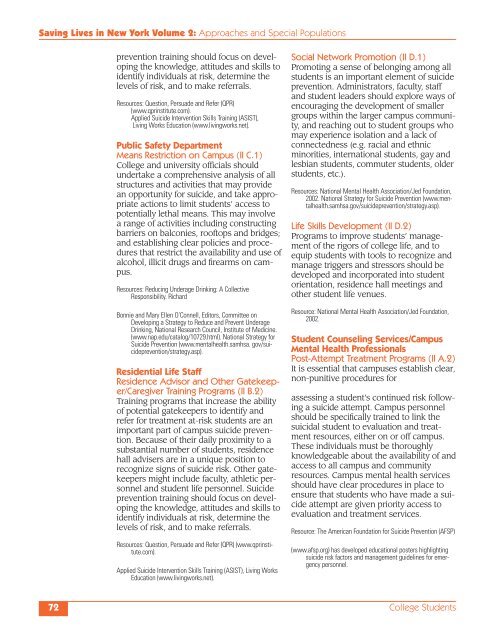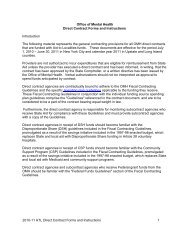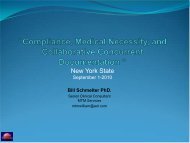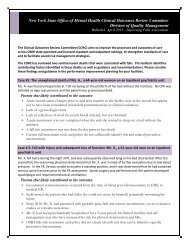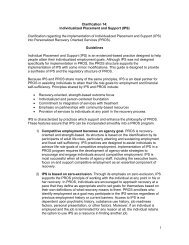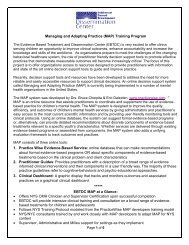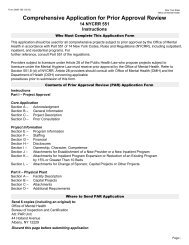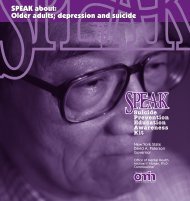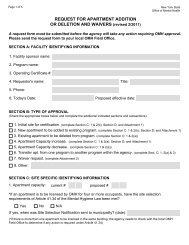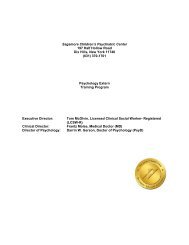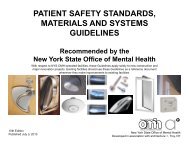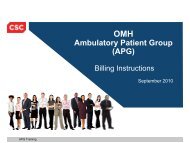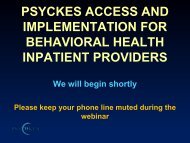Download - New York State Office of Mental Health
Download - New York State Office of Mental Health
Download - New York State Office of Mental Health
Create successful ePaper yourself
Turn your PDF publications into a flip-book with our unique Google optimized e-Paper software.
Saving Lives in <strong>New</strong> <strong>York</strong> Volume 2: Approaches and Special Populations<br />
prevention training should focus on developing<br />
the knowledge, attitudes and skills to<br />
identify individuals at risk, determine the<br />
levels <strong>of</strong> risk, and to make referrals.<br />
Resources: Question, Persuade and Refer (QPR)<br />
(www.qprinstitute.com).<br />
Applied Suicide Intervention Skills Training (ASIST),<br />
Living Works Education (www.livingworks.net).<br />
Public Safety Department<br />
Means Restriction on Campus (II C.1)<br />
College and university <strong>of</strong>ficials should<br />
undertake a comprehensive analysis <strong>of</strong> all<br />
structures and activities that may provide<br />
an opportunity for suicide, and take appropriate<br />
actions to limit students’ access to<br />
potentially lethal means. This may involve<br />
a range <strong>of</strong> activities including constructing<br />
barriers on balconies, ro<strong>of</strong>tops and bridges;<br />
and establishing clear policies and procedures<br />
that restrict the availability and use <strong>of</strong><br />
alcohol, illicit drugs and firearms on campus.<br />
Resources: Reducing Underage Drinking: A Collective<br />
Responsibility. Richard<br />
Bonnie and Mary Ellen O’Connell, Editors, Committee on<br />
Developing a Strategy to Reduce and Prevent Underage<br />
Drinking, National Research Council, Institute <strong>of</strong> Medicine.<br />
(www.nap.edu/catalog/10729.html). National Strategy for<br />
Suicide Prevention (www.mentalhealth.samhsa. gov/suicideprevention/strategy.asp).<br />
Residential Life Staff<br />
Residence Advisor and Other Gatekeeper/Caregiver<br />
Training Programs (II B.2)<br />
Training programs that increase the ability<br />
<strong>of</strong> potential gatekeepers to identify and<br />
refer for treatment at-risk students are an<br />
important part <strong>of</strong> campus suicide prevention.<br />
Because <strong>of</strong> their daily proximity to a<br />
substantial number <strong>of</strong> students, residence<br />
hall advisers are in a unique position to<br />
recognize signs <strong>of</strong> suicide risk. Other gatekeepers<br />
might include faculty, athletic personnel<br />
and student life personnel. Suicide<br />
prevention training should focus on developing<br />
the knowledge, attitudes and skills to<br />
identify individuals at risk, determine the<br />
levels <strong>of</strong> risk, and to make referrals.<br />
Resources: Question, Persuade and Refer (QPR) (www.qprinstitute.com).<br />
Applied Suicide Intervention Skills Training (ASIST), Living Works<br />
Education (www.livingworks.net).<br />
Social Network Promotion (II D.1)<br />
Promoting a sense <strong>of</strong> belonging among all<br />
students is an important element <strong>of</strong> suicide<br />
prevention. Administrators, faculty, staff<br />
and student leaders should explore ways <strong>of</strong><br />
encouraging the development <strong>of</strong> smaller<br />
groups within the larger campus community,<br />
and reaching out to student groups who<br />
may experience isolation and a lack <strong>of</strong><br />
connectedness (e.g. racial and ethnic<br />
minorities, international students, gay and<br />
lesbian students, commuter students, older<br />
students, etc.).<br />
Resources: National <strong>Mental</strong> <strong>Health</strong> Association/Jed Foundation,<br />
2002. National Strategy for Suicide Prevention (www.mentalhealth.samhsa.gov/suicideprevention/strategy.asp).<br />
Life Skills Development (II D.2)<br />
Programs to improve students’ management<br />
<strong>of</strong> the rigors <strong>of</strong> college life, and to<br />
equip students with tools to recognize and<br />
manage triggers and stressors should be<br />
developed and incorporated into student<br />
orientation, residence hall meetings and<br />
other student life venues.<br />
Resource: National <strong>Mental</strong> <strong>Health</strong> Association/Jed Foundation,<br />
2002.<br />
Student Counseling Services/Campus<br />
<strong>Mental</strong> <strong>Health</strong> Pr<strong>of</strong>essionals<br />
Post-Attempt Treatment Programs (II A.2)<br />
It is essential that campuses establish clear,<br />
non-punitive procedures for<br />
assessing a student’s continued risk following<br />
a suicide attempt. Campus personnel<br />
should be specifically trained to link the<br />
suicidal student to evaluation and treatment<br />
resources, either on or <strong>of</strong>f campus.<br />
These individuals must be thoroughly<br />
knowledgeable about the availability <strong>of</strong> and<br />
access to all campus and community<br />
resources. Campus mental health services<br />
should have clear procedures in place to<br />
ensure that students who have made a suicide<br />
attempt are given priority access to<br />
evaluation and treatment services.<br />
Resource: The American Foundation for Suicide Prevention (AFSP)<br />
(www.afsp.org) has developed educational posters highlighting<br />
suicide risk factors and management guidelines for emergency<br />
personnel.<br />
72 College Students


